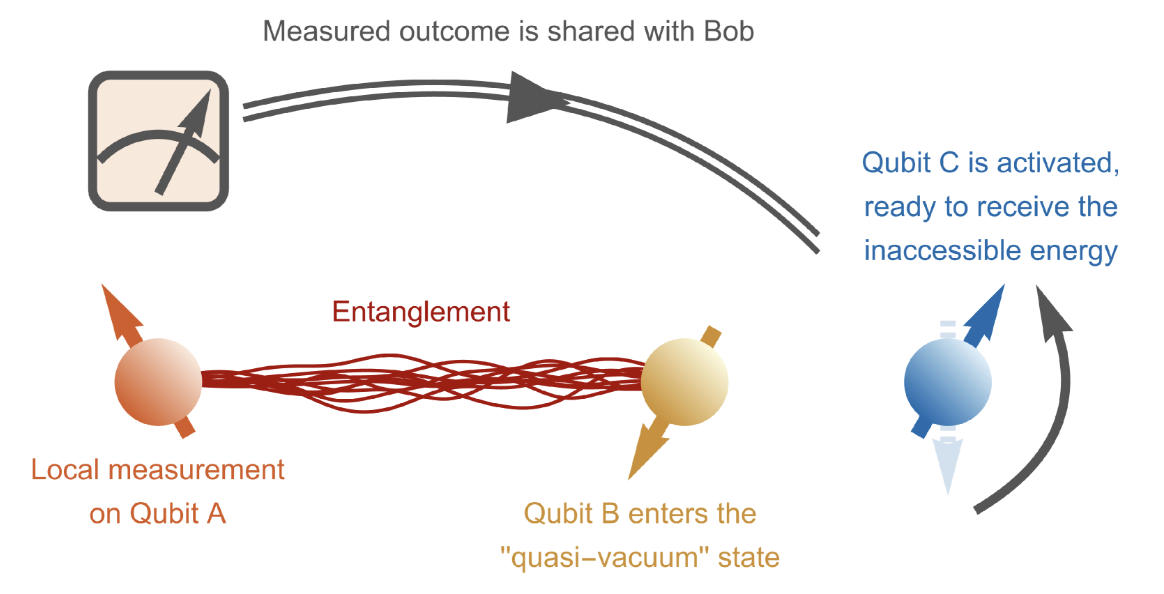Physicists Unlock New Protocol for Energy Teleportation and Storage Using Quantum Computers

Insider Brief
- Scientists at Purdue University have developed a method to teleport and store quantum energy from a quasi-vacuum state, offering new possibilities for quantum computing.
- The enhanced QET protocol uses an additional qubit to store teleported energy, overcoming previous limitations where energy was lost into classical devices.
- While tested successfully on quantum computers, more definitive experiments using real-world systems like carbon atoms are required to confirm its practical application.
Scientists report they have taken a step forward in the manipulation of quantum energy, developing a method to teleport energy from what appears to be empty space and store it for later use.
The team of Purdue University researchers said the technique might help power tomorrow’s quantum computers, adding that they tested this new protocol using IBM’s superconducting quantum computers, as reported in New Scientist and a preprint published on arXiv.
The Quantum Energy Teleportation Protocol
Quantum physics reveals that space, even when devoid of atoms, is never completely empty. What may seem like a vacuum still contains tiny fluctuations in quantum fields, often referred to as zero-point energy. These flickers of energy can be harvested using quantum energy teleportation (QET), a concept proposed by Masahiro Hotta in 2008. However, a persistent limitation of QET protocols was that the energy, once teleported, could not be stored and was lost into classical devices.
Sabre Kais, director of the Center for Quantum Technology and Distinguished Professor of Chemistry, and his team at Purdue, have addressed this issue by incorporating a quantum register to store the teleported energy.
QET protocols involve extracting energy from what physicists call a “quasi-vacuum” state. A true vacuum is often thought to be completely empty, but in quantum mechanics, a vacuum contains zero-point energy. This energy, while being the lowest possible energy a quantum system can have, can be manipulated through entanglement—a phenomenon where quantum particles remain correlated regardless of the distance separating them.
Hotta’s original protocol relied on entangled qubits, the building blocks of quantum computers, to teleport energy between two locations. Using our trusty quantum scientist Alice and Bob in the standard QET scenario: Alice measures her qubit, which affects its energy state, and then relays this information to Bob, who can then extract energy from his entangled qubit. The energy harvested in these cases is small and fragile, prone to leaking back into the environment before it can be harnessed.
Kais and his team’s solution incorporates a third qubit, which acts as an energy storage unit.
“This was our goal, to save it for future use,” said Songbo Xie, one of the researchers involved, as reported by New Scientist. By using this additional qubit to store the teleported energy, the team ensures that the energy is not lost and can be accessed later.
Experimental Validation
To test the enhanced QET protocol, the researchers used IBM’s superconducting quantum computers to simulate and execute energy teleportation. The results aligned with their theoretical predictions, providing evidence that the protocol is feasible. The experiments were conducted on quantum hardware rather than classical simulators, bringing the theoretical work closer to practical realization. According to the researchers, the addition of the third qubit successfully stored the extracted energy, overcoming the limitations of previous QET protocols.
While the results are promising, Eduardo Martín-Martínez from the University of Waterloo, who was involved in earlier QET experiments, emphasized the need for more definitive experiments. He suggests using physical systems like carbon atoms as the next step, as current implementations are more akin to simulations rather than true experimental realizations.
Implications for Quantum Computing and Future Applications
The ability to teleport and store energy could open new possibilities for quantum technologies, including applications in quantum computing.
“Such a teleported energy storage technology will be important in the future, since the stored energy can be used for other quantum tasks in quantum computers and other devices,” Hotta told New Scientist.
In quantum computing, energy management is a critical challenge. The capacity to extract and store energy from a vacuum state introduces new methods of energy handling in quantum circuits. Kais, who is also a chemist, envisions using this stored energy to trigger controlled chemical reactions.
Challenges and Future Work
Despite the successful demonstration, several challenges remain before the protocol can be widely adopted. The extracted energy is small and fragile, requiring meticulous control and further refinement of the storage mechanisms. The current experiments also relied on quantum computer simulations, which offer a level of abstraction not present in physical implementations.
Martín-Martínez pointed out that using real-world systems, such as carbon atoms, could offer a more concrete test of the protocol. Moving from simulations to actual physical systems would provide the definitive proof needed to establish the protocol’s viability beyond theoretical and simulated environments.
Moreover, scaling the protocol to work with more significant amounts of energy or in larger systems will likely require additional innovations in quantum energy management. The next steps, according to the researchers, involve implementing the protocol on other quantum platforms like nuclear magnetic resonance (NMR) systems to further validate its feasibility and effectiveness.
Manas Sajjan, Post-Doctoral Scholar, Purdue University, also worked with Xie and Kais on the study.
The Office of Science through the Quantum Science Center (QSC), a National Quantum Information Science Research Center, and the U.S. Department of Energy (DOE) (Office of Basic Energy Sciences) helped fund the project.
